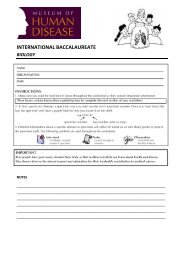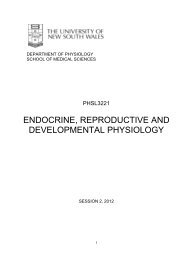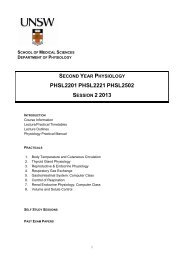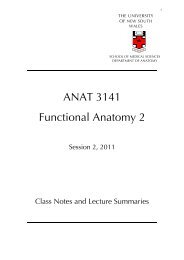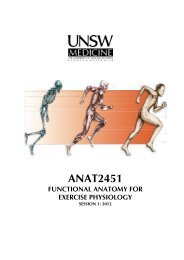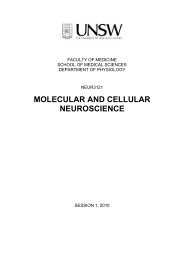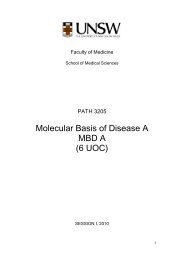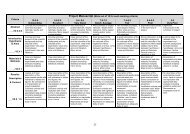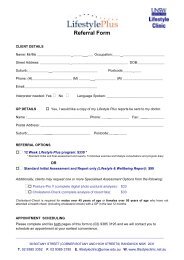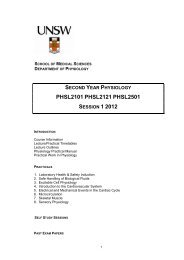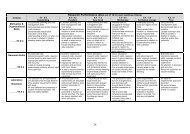PHSL2201 PHSL2221 PHSL2502 - School of Medical Sciences
PHSL2201 PHSL2221 PHSL2502 - School of Medical Sciences
PHSL2201 PHSL2221 PHSL2502 - School of Medical Sciences
Create successful ePaper yourself
Turn your PDF publications into a flip-book with our unique Google optimized e-Paper software.
5. Control <strong>of</strong> gastro-intestinal tract motility. The GIT is controlled by nerves from the<br />
central nervous system as well as nerves originating from within the GIT. These nerves<br />
are known as the enteric nervous system (ENS). The role <strong>of</strong> the ENS, the types <strong>of</strong><br />
neurons and the neurotransmitters they use and how reflexes are initiated will be<br />
covered. (PB)<br />
6. The structure and function <strong>of</strong> the large intestine. The large intestine plays a role in<br />
the storage <strong>of</strong> contents and in the absorption <strong>of</strong> water and electrolytes. We will focus<br />
on how the functions <strong>of</strong> the large intestine compare to, and are coordinated by, other<br />
parts <strong>of</strong> the GIT. The basic movements <strong>of</strong> the large intestine and the role bacterial<br />
colonies may play will be addressed. (PB)<br />
7. Appetite control: Factors that control appetite in the short and long term. Role <strong>of</strong> the<br />
brain in appetite control - brain:gut communication and the importance <strong>of</strong> adipose tissue<br />
as an endocrine organ. What goes wrong in obesity (MJM)<br />
KIDNEY AND BODY FLUIDS<br />
1. Body fluids and introduction to the kidney. Functions <strong>of</strong> the kidneys. Osmosis,<br />
osmolality, osmolarity, tonicity, osmotic pressure, colloid osmotic pressure. Volumes<br />
and composition <strong>of</strong> the body fluid compartments. Basic anatomy <strong>of</strong> the urinary system.<br />
2. Renal structures, renal blood flow and glomerular filtration. Structure <strong>of</strong> the<br />
nephron. Cortical and juxtamedullary nephrons. The juxtaglomerular apparatus. Renal<br />
blood flow. Renal sympathetic nerves. Basic steps in forming urine. Glomerular<br />
filtration and glomerular filtration rate (GFR). Filtration fraction. Equation for single<br />
nephron GFR. Effects <strong>of</strong> arteriolar tone on RBF and GFR. Autoregulation and<br />
tubuloglomerular feedback.<br />
3. Reabsorption and secretion; Evaluating renal function. Comparison <strong>of</strong> filtrate and<br />
urine. Basic mechanisms <strong>of</strong> transepithelial transport. Transepithelial transport <strong>of</strong><br />
sodium, water, glucose. Tm limited reabsorption. Calculation <strong>of</strong> filtered load, excretion<br />
rate, net reabsorption or secretion. Renal clearance. Use <strong>of</strong> clearance to measure<br />
GFR and effective renal plasma flow.<br />
4. Tubular structure and function along the nephron; Renal water homeostasis.<br />
Structure and function <strong>of</strong> the proximal tubule. Glomerulotubular balance. Transport<br />
properties <strong>of</strong> the loop <strong>of</strong> Henle, distal convoluted tubule and collecting duct. Water<br />
balance. Regulation <strong>of</strong> plasma osmolality. Thirst. Antidiuretic hormone. Making a<br />
dilute or concentrated urine. Obligatory water loss.<br />
5. Urinary concentrating mechanisms; Renal sodium homeostasis. The medullary<br />
osmotic gradient and its generation and maintenance: countercurrent multiplication,<br />
urea recycling and countercurrent exchange. Sodium balance. Sodium and<br />
extracellular volume. Detecting changes in sodium intake. Efferent mechanisms to vary<br />
sodium output.<br />
6. Renal sodium and potassium balance. Hormones involved in sodium balance. The<br />
renin angiotensin aldosterone system. Potassium balance. Buffering <strong>of</strong> extracellular<br />
potassium by the tissues. Renal handling <strong>of</strong> potassium. Mechanism <strong>of</strong> potassium<br />
secretion by principal cells. Factors affecting potassium secretion.<br />
7. Renal acid-base balance. Metabolic production <strong>of</strong> volatile and fixed acid.<br />
Physiological buffers. Henderson-Hasselbalch equation for HCO 3 - . Basic mechanism<br />
for secretion <strong>of</strong> H + . Reabsorption and manufacture <strong>of</strong> HCO 3 - . Urinary buffers and<br />
22



